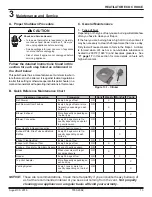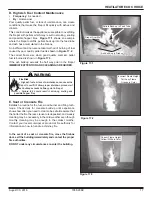
August 30, 2016
7058-206E
7
HEATILATOR ECO CHOICE
User Guide
2
Operating Instructions
A. Fire Safety
To provide reasonable fire safety, the following should be
given serious consideration:
• Install at least one smoke detector and CO
monitor on each
floor of your home.
• Locate detectors away from the heating appliance and close
to the sleeping areas.
• Follow the detector’s manufacturer’s placement and
installation instructions and maintain regularly.
• Conveniently locate a Class A fire extinguisher to contend
with small fires.
• In the event of a hopper fire:
• Evacuate the house immediately.
• Notify fire department.
B. Non-Combustible Materials
Material which will not ignite and burn, composed of any
combination of the following:
- Steel
- Plaster
- Glass - Tile
- Brick
- Iron
- Slate - Concrete
Materials reported as passing
ASTM E 136, Standard
Test Method for Behavior of Metals, in a Vertical Tube
Furnace of 750° C.
C. Combustible Materials
Material made of/or surfaced with any of the following
materials:
- Compressed Paper - Wood - Plywood/OSB
- Sheet Rock (drywall) - Plastic - Plant Fibers
Any material that can ignite and burn: flame proofed or not,
plastered or un-plastered.
D. Fuel Material and Fuel Storage
Pellet fuel quality can greatly fluctuate. This appliance has
been designed to burn a wide variety of fuels, giving you the
choice to use the fuel that is most economical in your region.
Hearth & Home Technologies strongly recommends only using
Pellet Fuel Institute (PFI) certified fuel.
Fuel Material
• Made from sawdust or wood by-products
• Depending on the source material it may have a high or
low ash content.
Higher Ash Content Material
• Hardwoods with a high mineral content
• Fuel that contains bark
• Standard grade pellets, high ash pellets,
Lower Ash Content Material
• Softwoods
• Fuels with low mineral content
• Premium grade pellets
Clinkers
Minerals and other non-combustible materials such as sand
will turn into a hard, glass-like substance called a clinker when
heated in the firepot.
Trees from different areas will vary in mineral content. That
is why some fuels produce more clinkers than others.
Moisture
Always burn dry fuel. Burning fuel with high moisture content
takes heat from the fuel and tends to cool the appliance,
robbing heat from your home. Damp pellet fuel can clog the
feed system.
Size
• Pellets are either 1/4 inch or 5/16 inch (6-8mm) in diameter
• Length should be no more that 1-1/2 inches (38mm)
• Pellet lengths can vary from lot to lot from the same
manufacturer
• Due to length variations, the flame height (feed rate) may
need adjusting occasionally. See
page 10
for instructions.
Performance
• Higher ash content requires the ash drawer to be emptied
more frequently
• Hardwoods require more air to burn properly
• Set wall control to “Utility Pellet” if the firepot and ash pan
are filling quickly. This will cause the auto-clean system
to empty the firepot more often.
• Premium wood pellets produce the highest heat output.
• Burning pellets longer than 1-1/2 inches (38mm) can cause
an inconsistent fuel feed rate and/or missed ignitions.
We recommend that you buy fuel in multi-ton lots whenever
possible. However, we do recommend trying various brands
before purchasing multi-ton lots to ensure your satisfaction.
Fire Risk.
• Do not operate appliance before reading and
understanding operating instructions.
• Failure to operate appliance properly may
cause a house fire.
WARNING








































